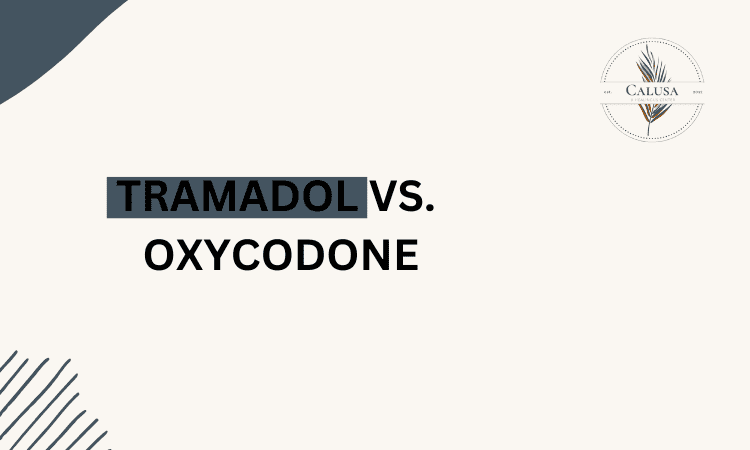It is very important to manage pain for those with chronic or acute pains. Most often, medical practitioners make use of prescription drugs such as Tramadol vs Oxycodone for instant relief. Depending on the severity of the pain and a patient’s personal needs, they are capable of providing different degrees of relief. Understanding these two medications differences is crucial when making an informed choice about which might be most suitable for you.
This blog will examine the benefits, downsides, and overall performance of Tramadol vs. Oxycodone. By the close of this blog, you’ll have a better understanding of how these drugs operate and which one could be more useful in controlling your pain.
No More Guesswork, Only Relief!
Discover how therapies like Cognitive Behavioral Therapy (CBT), Medication-Assisted Treatment (MAT), or family counseling can support you while finding the right medication.
What Are Tramadol and Oxycodone?
Distinguishing between Tramadol vs Oxycodone begins with knowing what each of these medicines is as well as how it operates.
At First The Tramadol
Tramadol is a synthetic opioid which means it is made in a lab to act like natural opioids; it helps relieve moderate pain and it’s less potent than stronger opioids such as oxycodone.
Mode Of Action
Tramadol functions by attaching itself to opioid receptors in the brain through which it blocks all painful signals sent to the brain; at times it also raises serotonin plus norepinephrine levels hence helping regulate mood together with pain respectively.
Oxycodone
This is a partially synthetic opiate, arising in part from natural sources and partly made in laboratories. It’s mainly used to relieve severe or moderate pain caused by surgeries or accidents.
How It Works
When compared with Tramadol, Oxycodone also attaches to opioid receptors in the brain and hence it has greater pain relief capacity. This is meant for immediate use when a person’s rate of pain needs quick and efficient attention.
Benefits of Tramadol vs Oxycodone
Before stating the difference between Tramadol vs Oxycodone, we must first understand what these drugs have to offer that is unique.
Tramadol
- Arthritis and back pain are often treated with tramadol; this drug can also be used for managing some forms of moderate pain. It’s safe for long-term use, therefore chronic pains can be managed using this drug without the intensity of stronger opioids.
- As compared to other opiates, tramadol has lower rates of abuse making it better suited for those individuals who fear addiction.
- Again, Tramadol is widely used in the management of chronic pain because it has a low potential for dependency that allows patients to continue with their usual activities without worrying about severe side effects or addiction.
Oxycodone
- Usually, oxycodone will be recommended if pain becomes more intense such as after surgery or a serious injury. Its strength makes it useful in cases of extreme urgency where quick and strong pain relief is needed.
- When pain is sudden and severe, Oxycodone is commonly the best choice due to its rapid action and powerful analgesic properties.
- Oxycodone usually moves at a faster rate than Tramadol, making it superior for managing prompt control when there is an emergency or immediately following surgery.
Tramadol vs. Oxycodone: Side Effects
Tramadol vs. Oxycodone – side effects are important to consider in each case. Learn them and you can make your own educated decision.
Tramadol
- Common Adverse Reactions
- Vertigo
- Feeling sick
- Bowel movement problems
- Throbbing head pains
Possible Seizure Risk
Tramadol also possesses the risk of provoking seizures especially in individuals with a history of epilepsy attacks or any other neurological disease whenever they exceed the recommended dosage.
Less Respiratory Depression Risk
Unlike potent opiates, Tramadol poses less risk of inducing respiratory depression that can result in a slow breathing rate up to dangerous levels.
Oxycodone
Common Side Effects
- Tiredness
- Problems with bowel movements
- Vomiting
- Itching
More Respiratory Depression Risk
Oxycodone has more chances to induce respiratory depression, especially at higher doses; therefore, one should use it according to prescription only.
High Potential for Abuse and Addiction
Typically prescribed for short-term use only, oxycodone is highly addictive as well as stronger than several other opioids.
Effectiveness: Tramadol vs Oxycodone
Effectiveness is an important aspect of the Tramadol vs Oxycodone debate. The efficacy of each drug would vary depending on the kind and intensity of pain.
Tramadol
- Moderate Pain Relief
Tramadol works well with moderate pain, which makes it ideal for chronic pain patients requiring continuous relief.
- Long-Term Use
Because it has a lower likelihood of addiction, Tramadol is often preferred over other options in the management of chronic pain.
- Slower Onset
Its delayed action distinguishes tramadol from oxycodone; hence, immediate relief situations may not be a good fit for its use.
Oxycodone
- Severe Pain Relief
Especially in acute situations that require fast intervention, oxycodone remains potent and effective in managing severe pain.
- Fast Acting
About tramadol, oxycodone acts at a faster pace thus bringing instant relief critical in post-surgical or injury-associated pain conditions.
- Short-Term Effectiveness
Due to its potential for addiction, oxycodone typically serves as a short-term solution and yet is efficient when used under careful monitoring.
Tramadol vs. Oxycodone: Which One Should You Choose?
Factors determining whether one should go for Tramadol or Oxycodone are
- Severity of Pain
Tramadol could be enough for moderate pain, while Oxycodone may be needed to treat severe pain.
- Side Effects and Tolerance
With less severe side effects, Tramadol is safer generally making it a better option for those who may want to avoid possible dangerous outcomes.
- Potential for Abuse
Even though Oxycodone is stronger and should be used with caution, it carries a higher risk of addiction compared to Tramadol which has a lower potential for abuse.
- Consultation with Healthcare Provider
The most efficient way of choosing between Tramadol vs Oxycodone might ultimately be through consulting a healthcare provider who can evaluate your particular situation and recommend the most suitable drug for your pain management needs.
Your Journey to a Brighter Tomorrow
Conclusion
When comparing Tramadol vs Oxycodone; the type and intensity of discomfort, potential secondary impacts along susceptibility to addiction are among the factors that can determine the choice. This makes it more useful in cases where there is chronic pain yet little chance of addiction occurring. On the other hand, Oxycodone provides relief from intense pain quicker and stronger but has a high possibility of misuse hence should only be used temporarily in extreme pain. To establish a solution tailored for you, speaking with a medic is essential.
If you’re unsure whether Tramadol vs Oxycodone is the right choice for your pain management, Calusa is here to help. Our experienced healthcare professionals can provide personalized advice and support, ensuring you get the best care for your pain relief needs. Contact Calusa today to schedule a consultation and find the pain management solution that works best for you.










